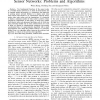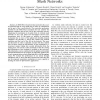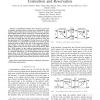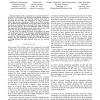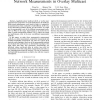INFOCOM
2007
IEEE
14 years 6 months ago
2007
IEEE
Abstract— TCP/IP can be interpreted as a distributed primaldual algorithm to maximize aggregate utility over source rates. It has recently been shown that an equilibrium of TCP/I...
INFOCOM
2007
IEEE
14 years 6 months ago
2007
IEEE
— The topological properties of peer-to-peer overlay networks are critical factors that dominate the performance of these systems. Several non-constant and constant degree interc...
INFOCOM
2007
IEEE
14 years 6 months ago
2007
IEEE
INFOCOM
2007
IEEE
14 years 6 months ago
2007
IEEE
—Mechanisms for data access and payment are central to the success of content delivery systems. However, not much attention has been paid to the issues of dishonest intermediarie...
INFOCOM
2007
IEEE
14 years 6 months ago
2007
IEEE
— Two fundamental functions of the sensor nodes in a wireless sensor network are to sense its environment and to transmit sensed information to a basestation. One approach to pro...
INFOCOM
2007
IEEE
14 years 6 months ago
2007
IEEE
—In IEEE 802.11-based wireless mesh networks a user is associated with an access point (AP) in order to communicate and be part of the overall network. The association mechanism ...
INFOCOM
2007
IEEE
14 years 6 months ago
2007
IEEE
—Many sensor network protocols in the literature implicitly assume that sensor nodes are deployed uniformly inside a simple geometric region. When the real deployment deviates fr...
INFOCOM
2007
IEEE
14 years 6 months ago
2007
IEEE
—Load-balanced switches have received a great deal of attention recently as they are much more scalable than other existing switch architectures in the literature. However, as th...
INFOCOM
2007
IEEE
14 years 6 months ago
2007
IEEE
Abstract—Digital media companies have recently started embracing P2P networks as an alternative distribution mechanism. However, with current P2P swarming systems users need to d...
INFOCOM
2007
IEEE
14 years 6 months ago
2007
IEEE
Abstract— Application-layer multicast (ALM, or overlay multicast) has been proposed to overcome limitations in IP multicast. While much measurement work (such as delay or connect...

